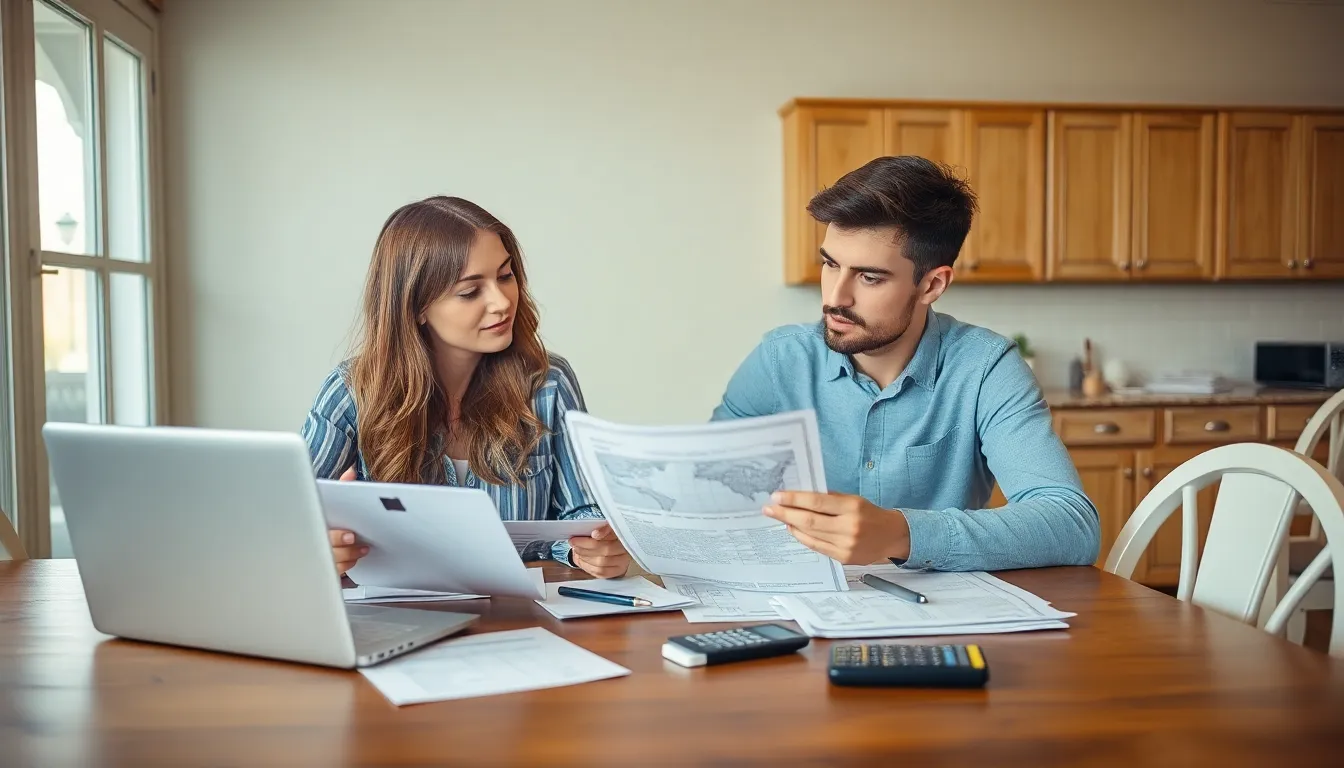Buying a house can feel like a wild rollercoaster ride—exciting yet terrifying. One moment you’re dreaming of backyard barbecues and cozy nights by the fireplace, and the next, you’re drowning in a sea of paperwork and mortgage jargon. But fear not! With the right guidance, this journey can be smoother than a freshly waxed floor.
Table of Contents
ToggleUnderstanding the Home Buying Process
Buying a house involves several essential steps. Understanding these steps simplifies the experience and reduces stress.
Steps Involved in Buying a House
First, determine the budget. Budget considerations include mortgage affordability and associated costs. Next, get pre-approved for a mortgage. Pre-approval helps clarify financial options and strengthens offers. Then, find a reliable real estate agent. Agents navigate the market and offer valuable insights. After that, search for homes that meet specific criteria. Focus on location, size, and amenities. Once an appealing property is found, make an offer. Offers can encounter negotiations and counteroffers. Finally, complete the closing process. Closing involves inspections, appraisals, and final paperwork.
Timeframe for Buying a Home
Timeframes can vary significantly based on personal circumstances. On average, the home-buying process takes about three to six months. This duration depends on market conditions and financing availability. Initial steps like getting pre-approved usually take one to two weeks. Finding the right home may take weeks to months. After an offer is accepted, closing can take 30 to 45 days. Preparation plays a key role; being organized can shorten this timeframe.
Preparing for Your Purchase

A solid foundation sets buyers up for success. Preparing for a home purchase involves understanding financial capabilities and securing financing.
Assessing Your Financial Situation
Buyers should review their savings, income, and expenses. Determining a budget includes calculating down payment amounts and ongoing monthly costs. Debt-to-income ratios usually play a crucial role in the assessment. Knowing these figures helps buyers identify their price range. Evaluating other financial commitments also reveals how much they can comfortably spend on a home. Aiming for a comfortable financial situation reduces future stress and enhances the buying experience.
Getting Pre-Approved for a Mortgage
Securing pre-approval simplifies the home-buying process. Sellers often prefer buyers with pre-approval letters, making offers more attractive. Gathering necessary documents like income statements, tax returns, and bank statements is essential for this step. Lenders use this information to assess borrowing potential and set loan limits. Understanding various mortgage types allows buyers to choose options that fit their goals. Timing the pre-approval process ideally ahead of house hunting increases confidence and expedites decisions.
Finding the Right Property
Finding the right property requires careful consideration of various factors, including neighborhoods and personal preferences.
Researching Neighborhoods
Choosing the right neighborhood is essential for long-term satisfaction. Start by identifying priorities, such as proximity to work, schools, and amenities. Explore different areas through online resources, local listing platforms, and neighborhood guides. Visit potential neighborhoods at various times to gauge ambiance and traffic patterns. Connect with residents and ask about their experiences to gain valuable insights. Crime rates, school ratings, and local activities play significant roles in neighborhood viability. Additionally, consider future developments that might impact property values.
Tips for Home Hunting
Effective home hunting involves strategic planning and organization. Create a wish list that outlines must-haves and nice-to-haves for the desired property. Prioritize essential features, such as the number of bedrooms, yard size, and layout. Utilize online tools and apps to filter options based on specific criteria. Attend open houses to get a feel for different properties firsthand. When exploring homes, take notes and pictures to help remember details later. Communicate clearly with your real estate agent about preferences and budget constraints. Be open to adjustments during the search while staying true to core requirements.
Making an Offer
Making an offer involves careful consideration and strategic planning. Crafting an offer letter captures the seller’s attention and demonstrates genuine interest.
Crafting Your Offer Letter
An effective offer letter personalizes communication, making it memorable. Buyers should share their personal story and highlight why the home resonates with them. Adding sincere compliments about the property fosters a connection. Specific details, such as the property’s unique features or the neighborhood, can enhance the letter’s appeal. Keep it concise yet heartfelt, aiming for a tone that reflects authenticity. Lastly, presenting the offer alongside this letter can make a compelling case for consideration.
Negotiating the Purchase
Negotiating the purchase involves employing tactics that benefit both parties. Understanding the local market allows buyers to make informed decisions on offer amounts. Start with a competitive offer based on comparable sales in the area. During the negotiation phase, stay flexible and open to counteroffers while clearly defining non-negotiable terms. Active communication with the seller or their agent can clear up uncertainties and foster cooperation. Maintaining professionalism and respect during discussions can lead to more conducive negotiations resulting in a successful agreement.
Closing the Deal
Closing a real estate deal marks a significant milestone in the home-buying journey. It involves several key components that finalize the transaction between the buyer and the seller.
Understanding Closing Costs
Closing costs typically range from 2% to 5% of the home’s purchase price. Buyers should prepare for various fees such as appraisal, title insurance, and attorney’s fees. Since these expenses can add up quickly, reviewing a detailed estimate prior to closing is beneficial. Lenders must provide a Loan Estimate that outlines expected closing costs and required funds. Buyers can negotiate some fees with the seller, which may help reduce overall expenses. Keeping track of these costs ensures financial preparedness and minimizes surprises on closing day.
Final Walkthrough and Closing Day
A final walkthrough occurs shortly before closing. This inspection allows buyers to confirm property conditions and ensure necessary repairs are completed. If any issues arise during the walkthrough, addressing them prior to closing is crucial. Closing day involves signing documents and transferring ownership. Buyers should come prepared with required identification and funds for closing costs. Notary services often verify signatures to complete the legal process. After finalizing the paperwork, buyers receive keys and officially become homeowners.
Buying a house can feel overwhelming but it’s also an exciting journey toward homeownership. By staying organized and informed throughout the process, potential buyers can navigate the complexities with confidence. From assessing finances to finding the right property and successfully closing the deal, each step plays a crucial role in achieving the dream of owning a home.
With the right guidance and preparation, the rollercoaster ride of buying a house can transform into a fulfilling experience. Embracing the process and understanding the key elements involved will ultimately lead to a successful purchase and a place to call home.







